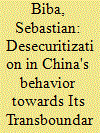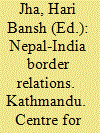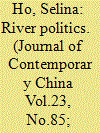| Srl | Item |
| 1 |
ID:
127771


|
|
|
|
|
| Publication |
2014.
|
| Summary/Abstract |
Fresh water has no substitute, and its availability has been declining sharply around the globe. In Asia, China's role as a multidirectional and transborder water provider is unmatched. Analysis of China's behavior towards its transboundary rivers is therefore pivotal. By examining three different case studies-the Mekong River in Southeast Asia, the Brahmaputra River in South Asia and the Irtysh and Ili Rivers in Central Asia-this article seeks to lay the theoretical groundwork for understanding China's behavior. It pits previously applied realist rationales against the more recent notion of desecuritization strategies and makes a case for the latter. While desecuritization implies non- or de-escalation, it does not necessarily mean genuine long-term cooperation. The future of Asia's shared waters may thus be a contentious one.
|
|
|
|
|
|
|
|
|
|
|
|
|
|
|
|
| 2 |
ID:
133907


|
|
|
|
|
| Publication |
2014.
|
| Summary/Abstract |
India and Central Asia constitutes strategic neighbours and natural allies. Both the regions are geographically proximate, share common history and cultural affinity. With this premise a modest attempt has been made to know what policies India follow in this region to secure and strive its interests and what more needs to be done. As stated above India requires to open up its diplomatic wings as far as cross border relations are concerned. Look North Policy which was planned long back to give a formal push remained under carpet for too long. There is an immediate and urgent need of this policy to be reactivated if at all India wants to play a big power role in world politics.
|
|
|
|
|
|
|
|
|
|
|
|
|
|
|
|
| 3 |
ID:
093458


|
|
|
|
|
| Publication |
kathmandu, Centre for Economic and Technical Studies (CETS), 1995.
|
| Description |
viii, 87p.
|
|
|
|
|
|
|
|
|
|
|
|
Copies: C:1/I:0,R:0,Q:0
Circulation
| Accession# | Call# | Current Location | Status | Policy | Location |
| 054641 | 327.54095496/JHA 054641 | Main | On Shelf | General | |
|
|
|
|
| 4 |
ID:
127770


|
|
|
|
|
| Publication |
2014.
|
| Summary/Abstract |
China manages its transboundary rivers as a subset of its broader relations with other riparian states. This results in discernible differences in the way China approaches its international river systems. Although there is a limit to the extent of Chinese cooperation, in relative terms China is more cooperative in the Mekong than in the Brahmaputra. To China, Southeast Asian states are part of a hierarchical system where it stands at the apex. While problems exist, there are deep linkages between them, which help foster collaboration in the Mekong. India, which has greater power parity with China, is not part of China's hierarchical worldview. The territorial disputes and security dilemmas that characterize South Asian geopolitics further impede cooperation. Domestic considerations also impact on China's river policies. There is greater consensus among Chinese policymakers in managing the Mekong than the Brahmaputra, which explains the higher degree of clarity in Chinese policies towards the former compared to the latter.
|
|
|
|
|
|
|
|
|
|
|
|
|
|
|
|